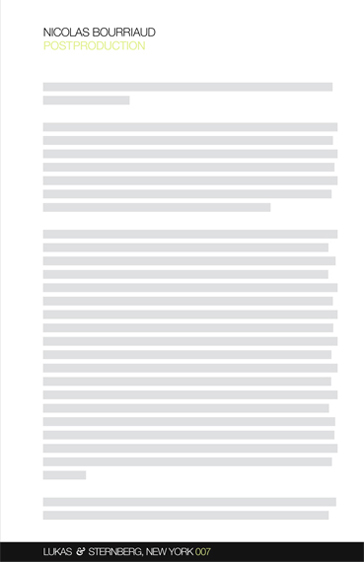Nicolas Bourriaud: Postproduction: Culture as Screenplay: How Art Reprograms the World (2002–) [EN, ES, CZ, HU, RO, BR-PT]
Filed under book | Tags: · 1990s, aesthetics, art history, art theory, contemporary art

“In this book, French writer and curator Nicolas Bourriaud discusses how, since the early nineties, an ever increasing number of artworks have been created on the basis of preexisting works; more and more artists interpret, reproduce, re-exhibit, or use works made by others or available cultural products.
This art of postproduction seems to respond to the proliferating chaos of global culture in the information age, which is characterized by an increase in the supply of works and the art world’s annexation of forms ignored or disdained until now.”
First published in French in 2002.
Translated by Jeanine Herman
Publisher Lukas & Sternberg, New York, 2002
Second edition, with a new preface, August 2005
ISBN 0974568899
96 pages
Review: Hal Foster (London Review of Books, 2003).
Publisher (EN)
Postproduction (English, trans. Jeanine Herman, 2005, updated on 2023-7-21)
Postproducción (Spanish, trans. Silvio Mattoni, 2004, added on 2023-7-21)
Postprodukce (Czech, trans. Petr Turek, 2004, added on 2014-2-25)
Utómunkálatok (Hungarian, trans. Jancsó Júlia, 2007, 55 MB, no OCR, updated on 2023-7-21)
Postproducţie (Romanian, trans. Cristian Nae, 2007, 56 MB, added on 2024-2-20)
Postprodukce (BR-Portuguese, trans. Denise Bottmann, 2009, added on 2024-2-20)
Boris Groys: Art Power (2008)
Filed under book | Tags: · art, art criticism, art history, art theory, contemporary art, iconoclasm, ideology, political art, politics

“Art has its own power in the world, and is as much a force in the power play of global politics today as it once was in the arena of cold war politics. Art, argues distinguished theoretician Boris Groys, is hardly a powerless commodity subject to the art market’s fiats of inclusion and exclusion. In Art Power, Groys examines modern and contemporary art according to its ideological function. Art, Groys writes, is produced and brought before the public in two ways—as a commodity and as a tool of political propaganda. In the contemporary art scene, very little attention is paid to the latter function; the official and unofficial art of the former Soviet Union and other former Socialist states, for example, is largely excluded from the field of institutionally recognized art, usually on moral grounds (although, Groys points out, criticism of the morality of the market never leads to calls for a similar exclusion of art produced under market conditions).
Arguing for the inclusion of politically motivated art in contemporary art discourse, Groys considers art produced under totalitarianism, Socialism, and post-Communism. He also considers today’s mainstream Western art—which he finds behaving more and more according to the norms of ideological propaganda: produced and exhibited for the masses at international exhibitions, biennials, and festivals. Contemporary art, Groys argues, demonstrates its power by appropriating the iconoclastic gestures directed against itself—by positioning itself simultaneously as an image and as a critique of the image. In Art Power, Groys examines this fundamental appropriation that produces the paradoxical object of the modern artwork.”
Publisher MIT Press, 2008
ISBN 0262072920, 9780262072922
224 pages
PDF (updated on 2012-7-15)
Comment (0)Jacques Rancière: The Politics of Aesthetics: The Distribution of the Sensible (2000-)
Filed under book | Tags: · aesthetics, art, art theory, avant-garde, philosophy, politics, subjectivation

“The Politics of Aesthetics rethinks the relationship between art and politics, reclaiming “aesthetics” from the narrow confines it is often reduced to. Jacques Rancière reveals its intrinsic link to politics by analysing what they both have in common: the delimitation of the visible and the invisible, the audible and the inaudible, the thinkable and the unthinkable, the possible and the impossible.
Presented as a set of inter-linked interviews, The Politics of Aesthetics provides the most comprehensive introduction to Rancière’s work to date, ranging across the history of art and politics from the Greek polis to the aesthetic revolution of the modern age.”
First published as Le partage du sensible: esthétique et politique, La Fabrique, 2000.
Translated with an introduction by Gabriel Rockhill
With an afterword by Slavoj Žižek
Published by Continuum, 2004
ISBN 0826489540, 9780826489548
116 pages
PDF (updated on 2024-2-20)
Comment (0)
